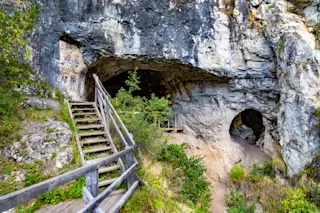In 1980, a Buddhist monk journeyed to Baishiya Karst Cave to pray. Located at the foot of a cliff at the edge of the Tibetan Plateau in Gansu, China, the cave’s opening, punched into a vertical expanse of gray stone, is such a picture-perfect embodiment of a monastic site that it almost veers into parody. It looks remarkably like a single eye socket, peering out across the river basin below. The tableau practically begs for a grizzled sage perched at the entrance, pondering some profundity or other.
We don’t know what this anonymous monk was in search of when he plodded up the path to the cave. But he descended with something much more concrete than the usual spiritual insights obtained from such a pilgrimage.
At some point during his stay, the monk found a strange mandible — a single length of jawbone studded with a handful of enormous molars. ...














